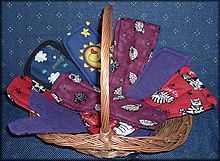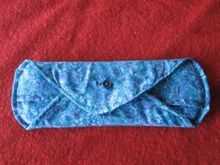Cloth menstrual pad
Cloth menstrual pads are a reusable alternative to disposable sanitary napkins.
They receive praise for being environmentally friendly, cost-cutting, as well as having purported health benefits.
Generally they are made from layers of absorbent fabrics (such as cotton or hemp) which are worn by a woman while she is menstruating, for post-birth bleeding or any other situation where it is necessary to absorb the flow of blood from the vagina, or to protect one's underwear from regular discharge of vaginal fluids. After use, they are washed, dried and then reused.[1]


History
Through the ages women have used different forms of menstrual protection.[2][3] Women often used strips of folded old cloth (rags) to catch their menstrual blood, which is why the term "rags" was used to refer to menstruation.
Disposable menstrual pads appear to have been first commercially available from around 1888 with the Southall's pad.[4] More widely successful disposable menstrual pads had their start during the first world war, when French nurses used Kimberly-Clark's wood pulp bandages as a menstrual pad that could be thrown away after use.[5] Kotex's first advertisement for products made with this wood pulp appeared in 1921.[6]
Until the advent of disposable pads, women used a variety of sewn or makeshift pads made from a variety of fabrics, often leftover scraps, to collect menstrual blood, although some women have used anything absorbent, to collect menstrual blood.[2] Fabrics could generally be washed and used again. When disposable pads were introduced, they were too expensive for many women to afford. When they could be afforded, women were allowed to place money in a box so that they would not have to speak to the clerk and take a box of Kotex pads from the counter themselves.[6] It took several years for disposable menstrual pads to become commonplace. However, they are now used nearly exclusively in most of the industrialized world.
Cloth menstrual pads made a comeback around 1970.[7] With the number of cloth pad manufacturers and online communities devoted to this increasing in the 1990s and the early 2000s, they appear to be gaining popularity.
In underdeveloped countries, reusable or makeshift pads are still used to collect menstrual blood.[8] Women in impoverished nations must often resort to either staying in their rooms during menstruation or using infection causing items such as leaves, husks, disposed cement bags, etc. This issue affects millions of women without access to feminine hygiene. This lack is directly tied to exploitation, drop out rates, infection, early marriage and even child trafficking.[9][10][11] Quality washable menstrual pads are now helping as worldwide awareness is growing and many NGO's are coordinating volunteers to sew effective washable pads with moisture barriers that, unlike disposables, can be used month after month.[10]
Current use
The majority of commercially available pads are manufactured by work-at-home moms or small businesses and can be purchased through some health food stores, specialty stores, and via the Internet. They are available in a range of lengths and thicknesses, similar to disposable pads, with longer pads for night use and thinner and shorter pads for light use. Some manufacturers will allow the buyer to select the fabrics, shape and size of the pad so that they can be custom made to fit an individual woman and be as efficient as possible.
Some women make their own cloth menstrual pads. These pads range from folded wash cloths to pads similar to the cloth menstrual pads available commercially.[12][13]
Cloth menstrual pads may be hand or machine washed, and then dried on a clothes line or in a clothes dryer, depending on the instructions from the manufacturer. (Different fabrics require different care methods.) Some women choose to rinse out their pads in cold water before putting them in the wash with their other clothing. Others do not rinse, but put the soiled pads straight into the wash.
When changing cloth menstrual pads away from home, some women place the soiled pads into a waterproof or Ziploc bag to keep them from drying out and to contain or prevent odor and then wash the pads when convenient.[14]
Stains sometimes occur. However, this is limited if the pads are rinsed out or soaked in cold water immediately after use. Some women prefer darker colored fabrics which do not show stains as much as light colored fabrics do. Causes of staining include allowing the blood to dry on the pad and using hot water when washing the pad. Drying cloth pads in sunlight can help to fade stains.[14]
The fabrics used range from 100% natural fibres to 100% synthetics. Some commonly used fabrics include terrycloth, cotton, silk, hemp, and Gore-Tex. Specialty fabrics such as hemp, bamboo terry, bamboo velour, soy French terry, wool interlock and polyurethane laminate (PUL). PUL may be purchased from online nappy/diaper supply stores.[14]
Some styles of cloth menstrual pad have a waterproof layer to help prevent the pad leaking through while other styles of cloth pad may rely on more layers of absorbency and not include waterproofing. Wool can also be used as a natural, breathable backing that provides leak protection.[14]
In Somalia, where girls may be absent from school for a week each month due to menstruation, a charity has trained victims of gender based violence to sew re-usable sanitary pads, which are then purchased for distribution to schools in Mogadishu.[15]
Perceived advantages and disadvantages
Advantages
- Cloth menstrual pads are environmentally friendly and do not contribute to landfill as they are reusable and do not come in or contain plastic packaging. When cloth menstrual pads wear out (after years of use), those made from natural materials can be composted whereas disposable sanitary napkins made from synthetic materials cannot be recycled or composted.[16] Fewer chemicals are used in the cloth compared to disposable menstrual products. They create less overall waste compared to disposable menstrual products as they can be made from reused materials, including old pillow cases and towels.[17] Some cloth pads use hemp as the absorbent core which is more environmentally friendly to grow when compared with cotton or wood pulp.[18] Organic options, such as pads made of organic cotton grown without pesticides and chemicals, are available.
- In the long term, it is less expensive to buy or make by hand cloth menstrual pads.
- While less convenient than disposables, they are still convenient as they can simply be cleaned in the washing machine.[19]
- Cloth menstrual pads are less likely to cause rashes, contact dermatitis, as well as helping women afflicted with certain types of vaginitis. Women with sensitive skin and allergies may prefer cloth pads made of undyed organic cotton. They do not use adhesive.
- Some cloth menstrual pads may reduce the scent of menstrual blood on the cloth pad.
- Some cloth pad makers run or donate a portion of their proceeds to programs that provide reusable feminine hygiene products to women in developing countries so that they can continue to go to school or work while menstruating.[20]
Disadvantages
- Washing reusable pads requires water, detergents, and electricity if not hand washed. Bloody cleaning water must be disposed of safely.
- Cloth menstrual pads are generally more time consuming due to the need to wash, dry, and care for the pads.
- Special care may need to be taken if the user has a Candidiasis infection (i.e. yeast infection). Once the infection is treated, the cloth menstrual pads should be sterilized to prevent reinfection.
- Initial cost for reusable menstrual products is typically higher per pad than for disposables.
- Blood-borne pathogens like hepatitis C are present in the menstrual pads of infected patients. They should be placed in leak-proof plastic bags. [21]
References
- ↑ Cavanaugh, Tim (1998-07-31). "Salon Mothers Who Think | Go with the flow". Salon.com. Retrieved 2012-09-18.
- ↑ 2.0 2.1 "What did American and European women use for menstruation in the past? at the Museum of Menstruation and Women's Health". Mum.org. Retrieved 2012-09-18.
- ↑ "Knitted Norwegian Pads at the Museum of Menstruation and Women's Healllth". Mum.org. Retrieved 2012-09-18.
- ↑ "Ads for early Southall's disposable menstrual pads in the U.K. at MUM". Mum.org. Retrieved 2012-09-18.
- ↑ "Ads for Hartmann's menstrual pad (1890s) at the Museum of Menstruation and Women's Health". Mum.org. Retrieved 2012-09-18.
- ↑ 6.0 6.1 "Inside the Museum of Menstruation 6". Mum.org. Retrieved 2012-09-18.
- ↑ "From the Collection of MUM: Washable Menstrual Pads and Underpants". Mum.org. Retrieved 2012-09-18.
- ↑ Rockwell, Page (2006-03-17). "Letters: Period pain in Zimbabwe". Salon. Retrieved 2012-09-18.
- ↑ "Half the Sky" by Nicholas Kristof and Sheryl Wudunn
- ↑ 10.0 10.1 "Days for Girls International". Daysforgirls.org. Retrieved 2012-09-18.
- ↑ Matendere, Brenna. "Sanitary ware emergency". The Zimbabwean. Retrieved 2012-09-18.
- ↑ Merchant, Brian (2007-11-19). "Bleed With Pride: Make-It-Yourself Menstrual Pads". TreeHugger. Retrieved 2012-09-18.
- ↑ "Microsoft Word - 4126C0AA-056B-204951.doc" (PDF). Retrieved 2012-09-18.
- ↑ 14.0 14.1 14.2 14.3 Obsidian (2009-02-21). "Cloth Menstrual Pads". Web.archive.org. Retrieved 2012-09-18.
- ↑ Comitato Internazionale per lo Sviluppo dei Popoli (2014-06-09). "GBV Survivors Trained to Make Re-usable Sanitary Pads for a Living - Somalia". ReliefWeb. Retrieved 2014-06-10.
- ↑ "What items can't be recycled at the kerbside Real Recycling collection?". Web.archive.org. 2009-02-22. Retrieved 2012-09-18.
- ↑ "Internet Archive Wayback Machine". Web.archive.org. 2007-02-22. Retrieved 2012-09-18.
- ↑ "Hemp - HIA". Web.archive.org. 2007-07-23. Retrieved 2012-09-18.
- ↑ "Cloth Menstrual Pads". Labyrinth.net.au. Retrieved 2012-09-18.
- ↑ "Huru". Huruinternational.org. Retrieved 2012-09-18.
- ↑ Hepatitis Australia